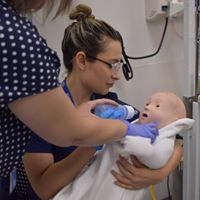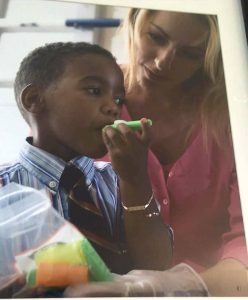SPRING 2023
Pediatric Feeding Disorder is best PREVENTED! like our Communication Disorders. Cohen & Dilfer (2022;article posted) provides convincing evidence for PFD to be considered an automatic qualifying diagnosis for EI services. READ on! Great read.
SPRING 2022
Tiffany Field found that imitating the child with Autism enhances Social Behavior (known as Copying by Hanen or Mirroring in other intervention frameworks).
Field, T. (2017). Imitation Enhances Social Behavior of Children with Autism Spectrum Disorder: A Review. Behavioral Development Bulletin, 22(1), 86-93.
Recycle this important article to the CLINICIAN’s Corner.
Echolalia is PART OF language development for children with Autism Spectrum Disorder (Stiegler, 2015). According to Marge Blanc lays out 6 stages to Natural Language Development (reviewed by Stiegler, 2015) and echolalia aids children with ASD to move into word combinations and spontaneous utterances. We should not extinguish Echolalia. Echolalia is communication!
Stiegler, L. (2015). Examining the Echolalia Literature: Where
Do Speech-Language Pathologists Stand?. AJSLP, 24, 750-762.
FALL 2020
Ethics and Cultural Competence are on everyone’s mind. https://www.asha.org/practice/ethics/cultural-and-linguistic-competence/
Culture and language may influence the behaviors of individuals but they do not imply deficits.
I have heard folks complain about fulfilling the new ethics requirement from ASHA. We need to keep up with ethical standards – all of us, and educate ourselves on the up-to-date standards in all areas of practice, especially ethics.
There are 2 exciting evidence-based updates for NICU Practice!
- Thao Griffith, Rosemary White-Traut, & Linda Witek Janusek (2020) A Behavioral Epigenetics Model to Predict Oral Feeding Skills in PreTerm Infants. Clinical Issues in Neonatal Care.
2. There are evidence-based guidelines put forth by an international panel of experts for NICU practice:
FALL 2019
This Term’s Clinical Topic: Echolalia
Stiegler (2015) shows us the position of ASHA: Echolalia is a communication tool. Echolalia is a strategy – to participate in communication and to formulate and understand language.
Echolalia serves a variety of pragmatic functions.
Extinction of echolalia is not appropriate because it serves communicative functions as children with autism spectrum disorder progress through Natural Language Acquisition (adapted from Marge Blanc in the article are stages children with ASD progress through).
___________________________________________________________________________
Summer 2018
Picky Eating in the Toddler Years ! Totally Normal. We have found in the Literature Refusal increases to 40% of the time! Here is a popular press article by CNN that quotes clinical experts!
Don’t Pressure Your Picky Eater – It Doesn’t Work!
https://www.cnn.com/2018/07/30/health/picky-eater-toddler-study/index.html
Fall 2017
An interesting dialogue regarding when infants have learned their name, as well as Mommy and Daddy. In clinical screenings (and evaluation) SLPs should always call the child’s name from behind by 6-7 months. Immediate Audiology referral for “failing to turn to name call”. I follow up in my screening with a “name + tactile cue”.
“There is a series of papers showing that they have learnt the word form of their own name it by 5 months…. They have started assigning a meaning to “mommy” and “daddy” (Tincoff & Juszcyk, 1999):
Mandel, D. R., Jusczyk, P. W., & Pisoni, D. B. (1995). Infants’ recognition of the sound patterns of their own names. Psychological Science, 6(5), 314-317.
Bouchon, C., Floccia, C., Fux, T., Adda‐Decker, M., & Nazzi, T. (2015). Call me Alix, not Elix: vowels are more important than consonants in own‐name recognition at 5 months. Developmental science, 18(4), 587-598.
Delle Luche, C., Floccia, C., Granjon, L., & Nazzi, T. (2017). Infants’ First Words are not Phonetically Specified: Own Name Recognition in British English‐Learning 5‐Month‐Olds. Infancy, 22(3), 362-388.”
Summer 2017
A highlight from my Early Intervention course!
Caregiver-Child Dyad observations occur each year in the graduate level course in Early Intervention at SHU.
Fall 2016
Susan Ebbels’ shape coding program was a terrific find! Every year we read her work in the Language Development and Disorders graduate course. This semester we found her formalized program and website:
http://www.moorhouseschool.co.uk/shape-coding
Summer 2016
Did you know that ASHA does not make Dysphagia Diet recommendations but has some terrific resources!!
My lab found these useful for our research on texture advancement:
http://www.asha.org/SLP/clinical/dysphagia/Dysphagia-Diets/
Winter 2016
I received an email from an alumna today. She remembers from many years ago a handout I had on Black English Features Variations. She was investigating “call and response” pragmatic variation type (Battle, 1993). Did I have any citations? She was interested in pulling together some literature. Found this interesting. Hope you do too:
http://leader.pubs.asha.org/article.aspx?articleid=2280637
Fall 2015
September!
Knowing our developmental milestones is the key to both evaluating any young child AND ensuring we are matching their level in therapy sessions. Several resources are used to gain knowledge across a variety of language domains but the Paul & Norbury Language Disorders in Children text is one we use. The front and back covers illustrate a variety of language age-milestones.
October!
10/7/15
This week we discussed Late Talkers in our Journal Club. Check out this terrific article by Leslie Rescorla (2011) that examines the outcomes of late talkers and potential predictors of outcomes.
Late Talkers Predictors of Outcomes
10/1/15
Today we discussed Sensory Processing Disorder in class. Many of our children with language impairments try to cope with this disorder.
A great video illustrating Sensory Processing Disorder!
Summer 2015
Our Early Intervention course discussed current EBP articles supporting naturalistic-, parent-training approaches! There
Spring 2015
This week in class we discussed PROMPT (Prompts for Reconstructing Oral Motor Phonetic Targets) as a technique to use in Speech-Language Therapy for children with Apraxia of speech.
Dayle & Hayden 2013 (See PROMPT Apraxia article) report PROMPT as an effective treatment strategy for children with childhood apraxia of speech.
PROMPT is a multidimensional approach to speech production disorders. Integration of all domains and systems benefits the overall communicative ability of the speaker. These domains include cognitive-linguistic, social-emotional aspects and physical-sensory aspects of motor performance. (See more at http://www.promptinstitute.com/)


